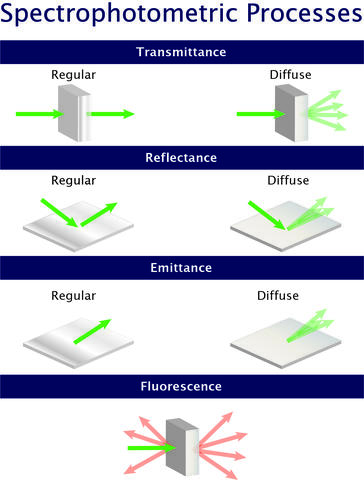Summary
Spectrophotometry is the quantitative measurement of the reflectance and transmittance of optical radiation in the ultraviolet, visible, and infrared spectral regions.
Description

NIST uses spectrophotometric techniques to measure the optical properties of materials for dissemination of national measurement scales to its stakeholders and advancing the development of standards, measurement methods, and modeling capabilities. The beneficiaries of these activities include the optics, photonics, color technology, instrument manufacturing, pharmaceutical, coating manufacturing, and remote sensing communities as well as military standards laboratories and other national metrology institutes.
The properties of a material, at the atomic and bulk levels, determine how light interacts with a material. For instance, atomic level properties affect how light passes through materials depending on its transmittance or absorption properties, while a material’s surface properties affect how light is reflected by the surface. Spectrophotometric techniques interrogate these material properties by illuminating a material with light and then detecting the light’s response to the material. At NIST, we use spectrophotometric techniques to measure the following optical properties: reflectance, transmittance, absorbance, emittance, and fluorescence.
While relatively simple in concept, measuring the optical properties of materials involves careful consideration of the geometrical and spectral conditions of measurement.
Calibrations:
Calibrations for optical properties of materials are through NIST Calibration Services at the NIST Storefront. The catalog of available calibrations include: reflectance, transmittance, and emittance. For some services, the measurement parameters are customizable, within the limits of our capabilities. Pricing is based on actual costs, labor and time, and various measurement parameters. Each calibration results in a calibration report which includes the calibrated values and uncertainties for the customer-supplied test item(s).
Standard Reference Materials:
NIST Standard Reference Materials (SRMs) can be used to calibrate, validate, or characterize spectrophotometers. The catalog of SRMs related to optical properties can be found here.
Measurement Capabilities:
NIST also maintains a wide variety of capabilities for spectrophotometric measurements that are not offered through NIST Calibration Services. These capabilities facilitate research projects, including collaborations with interested parties both internal and external to NIST.
- Optical grating scatterometry
- Optical scattering from surfaces
- Reflectance and transmittance
- Diffuse optical properties of materials
- Infrared optical properties of materials and components
Applications:
Below some examples of the applications of NIST’s spectrophotometric capabilities.
- Aerospace and defense industries
- Human skin reflectance
- Infrared optical engineering
- Fluorescence studies
- Reflectance measurements for validating the efficacy and safety of UV-C disinfection systems
- Traceability in molecular spectrophotometry
Opportunities for Collaboration:
The Sensor Science Division provides multiple opportunities for students, scientists, industry, academia, and other R&D laboratories to collaborate on scientific research. Specific opportunities depend on current areas of interest within the Division, but may include undergraduate research fellowship, postdoctoral fellowships, visiting scientist, and guest researchers as well as various cooperative research arrangements range from formal agreements, such as CRADA and Consortia, to informal collaborations. For more details, see Employment Opportunities.

